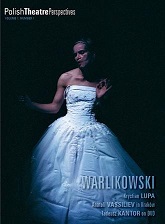‘...a signal of shrinking time’: Kantor on Film
‘...a signal of shrinking time’: Kantor on Film
Author(s): Daniel WattSubject(s): Theatre, Dance, Performing Arts
Published by: Instytut im. Jerzego Grotowskiego
Keywords: Tadeusz Kantor; Polish theatre; Theatre documentation; Theatre on DVD; Theatre on film; Theatre of Death; Dead Class; Wielopole
Summary/Abstract: Tadeusz Kantor continually commented on the nature of the frozen images that returned to him from his past: faded ‘negatives’ of family and friends, moments of high emotion and ‘banal, elementary, and aimless activities’ all contributing to the endless, personal, theatre of memory. These images were folded into every performance, and then repeatedly returned to, unearthed, reformed and represented. In a sense Kantor already worked as a painstaking re-animator of the already existing, or the already fading. Kantor’s careful theoretical articulation of theatre space shows many similarities to cinematic concepts of framing, with one important difference: the issue of reality. The totality of the stage spaces – their actors, objects and audience – were all a challenge to reality; a poor bio-object that asserted another order of event and challenged the homogeneity of culture and the academy. There is a tension between the biographical performances and the experimental cricotage (which aimed to ‘negate and erase’ ‘all meanings operating in life’); between the real events of the past and the anarchic creativity of art. Can the recordings of these performances reveal aspects of Kantor’s thought and work previously hidden within the event of performance? Indeed, can they ever produce the same challenge to time, memory and reality that the stage space offered? This short essay plays through the possible contradictions between the event of performance (the bio-object) and the urge to create an archive that would eternally repeat his work. Exploring the ten DVDs of film, filmed performances and documentaries released by Cricoteka from 2006-2008, this essay questions the nature of time and memory on film and whether from the flat screen of repeatable visual ‘“sameness” something utterly, but utterly, different’ emerges.
Journal: Polish Theatre Perspectives (PTP)
- Issue Year: 2010
- Issue No: 1.1
- Page Range: 319-328
- Page Count: 10
- Language: English

